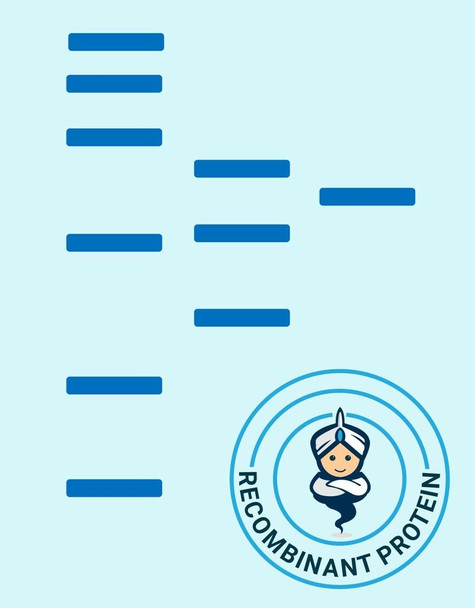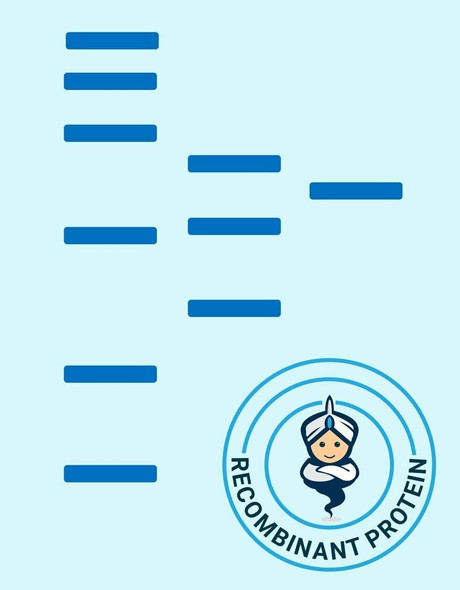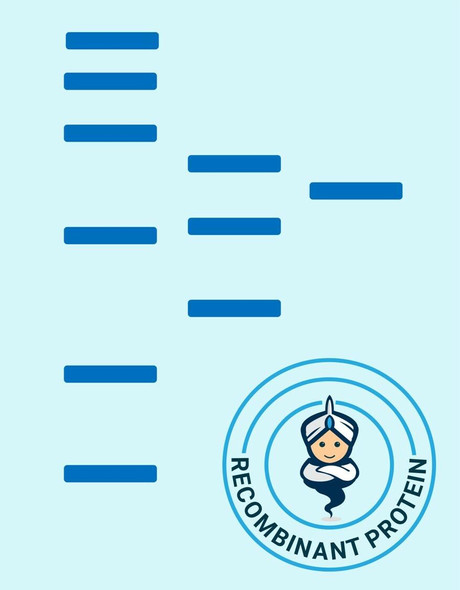Human FGF 19 Recombinant Protein (RPPB0239)
- SKU:
- RPPB0239
- Product type:
- Recombinant Protein
- Size:
- 25ug
- Species:
- Human
- Target:
- FGF 19
- Synonyms:
- Fibroblast growth factor 19
- FGF-19
- Source:
- Escherichia Coli
- Uniprot:
- O95750
Description
| Product Name: | Human FGF 19 Recombinant Protein |
| Product Code: | RPPB0239 |
| Size: | 25µg |
| Species: | Human |
| Target: | FGF 19 |
| Synonyms: | Fibroblast growth factor 19, FGF-19. |
| Source: | Escherichia Coli |
| Physical Appearance: | Filtered white lyophilized powder. |
| Formulation: | Filtered (0.4µm) and lyophilized from 0.5mg/ml in 20mM TRIS, 20mM NaCl, pH 7.5. |
| Solubility: | Add deionized water to a working concentration approximately 0.5mg/ml and let the lyophilized pellet dissolve completely. Product is not sterile! Please filter the product by appropriate sterile filter before using it in the cell culture. |
| Stability: | Lyophilized FGF-19 Human Recombinant although stable at room temperature for 3 weeks, should be stored desiccated below -18°C. Upon reconstitution Fibroblast Growth Factor-19 should be stored at 4°C between 2-7 days and for future use below -18°C.For long term storage it is recommended to add a carrier protein (0.1% HSA or BSA).Please prevent freeze-thaw cycles. |
| Purity: | Greater than 95.0% as determined by SDS-PAGE. |
| Amino Acid Sequence: | MRGSHHHHHH GMASLAFSDA GPHVHYGWGD PIRLRHLYTS GPHGLSSCFL RIRADGVVDC ARGQSAHSLLEIKAVALRTV AIKGVHSVRY LCMGADGKMQ GLLQYSEEDC AFEEEIRPDG YNVYRSEKHR LPVSLSSAKQ RQLYKNRGFL PLSHFLPMLP MVPEEPEDLR GHLESDMFSS PLETDSMDPF GLVTGLEAVR SPSFEK |
The FGFs are a family of more than 20 small (~17–26 kDa) secreted peptides. The initial characterization of these proteins focused on their ability to stimulate fibroblast proliferation. This mitogenic activity was mediated through FGF receptors (FGFRs) 1, 2, or 3. A fourth closely related tyrosine kinase receptor (FGFR4) was able to bind the FGFs but did not lead to a mitogenic response.FGFs modulate cellular activity via at least 5 distinct subfamilies of high-affinity FGF receptors (FGFRs): FGFR-1, -2, -3, and -4, all with intrinsic tyrosine kinase activity and, except for FGFR-4, multiple splice isoforms, and FGFR-5, which lacks an intracellular kinase domain. There is growing evidence that FGFRs can be important for regulation of glucose and lipid homeostasis. The overexpression of a dominant negative form of FGFR-1 in cells leads to diabetes in mice, which thus implies that proper FGF signaling is required for normal cell function and glycemia maintenance. FGFR-2 appears to be a key molecule during pancreatic development. Moreover, FGFR-4 has been implicated in cholesterol metabolism and bile acid synthesis.FGF-19, has been shown to cause resistance to diet-induced obesity and insulin desensitization and to improve insulin, glucose, and lipid profiles in diabetic rodents. Since these effects, at least in part, are mediated through the observed changes in metabolic rates, FGF-19 can be considered as a regulator of energy expenditure.FGF-21 is preferentially expressed in liver, but an exact knowledge of FGF-21 bioactivity and its mode of action have been lacking to date. FGF-21 is a potent activator of glucose uptake on adipocytes, protects animals from diet-induced obesity when overexpressed in transgenic mice, and lowers blood glucose and triglyceride levels when therapeutically administered to diabetic rodents.
Fibroblast Growth Factor-19 Human Recombinant produced in E.Coli is a single, non-glycosylated, polypeptide chain containing 206 amino acids and having a molecular mass of 23 kDa. The amino acid sequence of the recombinant human FGF19 is 100% homologous to the amino acid sequence of the human FGF19 without signal sequence and contains his tag at N-terminal. The FGF-19 is purified by proprietary chromatographic techniques.
| UniProt Protein Function: | FGF19: Involved in the suppression of bile acid biosynthesis through down-regulation of CYP7A1 expression, following positive regulation of the JNK and ERK1/2 cascades. Stimulates glucose uptake in adipocytes. Activity requires the presence of KLB and FGFR4. Belongs to the heparin-binding growth factors family. |
| UniProt Protein Details: | Protein type:Motility/polarity/chemotaxis; Cytokine; Secreted, signal peptide; Secreted; Cell development/differentiation Chromosomal Location of Human Ortholog: 11q13.1 Cellular Component: extracellular region Molecular Function:protein binding; growth factor activity; fibroblast growth factor receptor binding Biological Process: epidermal growth factor receptor signaling pathway; nervous system development; positive regulation of glucose import; fibroblast growth factor receptor signaling pathway; phosphoinositide-mediated signaling; nerve growth factor receptor signaling pathway; heart development; positive regulation of cell proliferation; insulin receptor signaling pathway; innate immune response; positive regulation of JNK cascade; positive regulation of protein amino acid phosphorylation; neural crest cell migration |
| NCBI Summary: | The protein encoded by this gene is a member of the fibroblast growth factor (FGF) family. FGF family members possess broad mitogenic and cell survival activities, and are involved in a variety of biological processes including embryonic development cell growth, morphogenesis, tissue repair, tumor growth and invasion. This growth factor is a high affinity, heparin dependent ligand for FGFR4. Expression of this gene was detected only in fetal but not adult brain tissue. Synergistic interaction of the chick homolog and Wnt-8c has been shown to be required for initiation of inner ear development. [provided by RefSeq, Jul 2008] |
| UniProt Code: | O95750 |
| NCBI GenInfo Identifier: | 11132196 |
| NCBI Gene ID: | 9965 |
| NCBI Accession: | O95750.1 |
| UniProt Related Accession: | O95750 |
| Molecular Weight: | 216 |
| NCBI Full Name: | Fibroblast growth factor 19 |
| NCBI Synonym Full Names: | fibroblast growth factor 19 |
| NCBI Official Symbol: | FGF19 |
| NCBI Protein Information: | fibroblast growth factor 19; FGF-19 |
| UniProt Protein Name: | Fibroblast growth factor 19 |
| Protein Family: | Fibroblast growth factor |
| UniProt Gene Name: | FGF19 |
| UniProt Entry Name: | FGF19_HUMAN |









